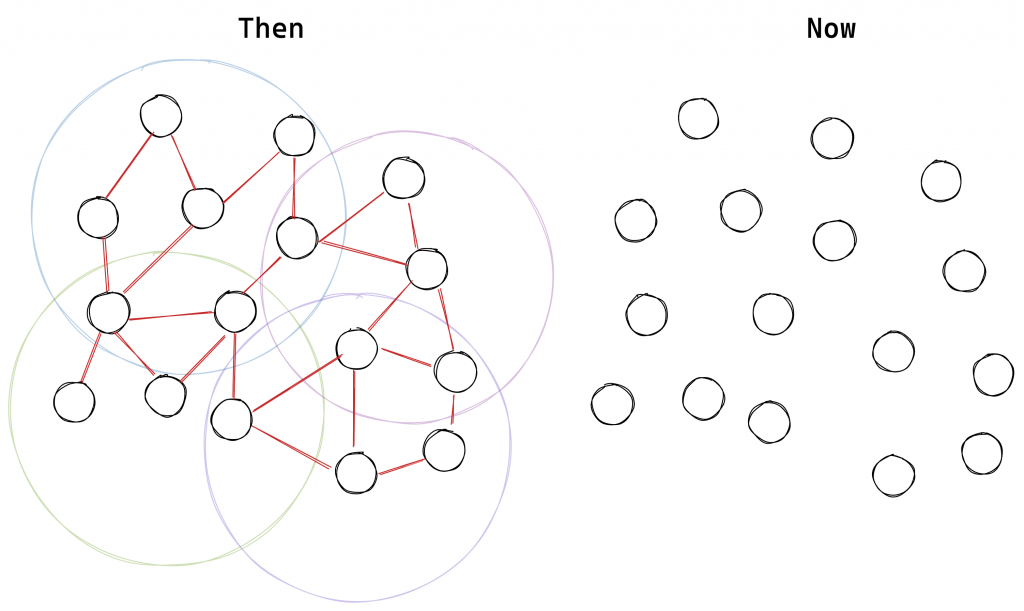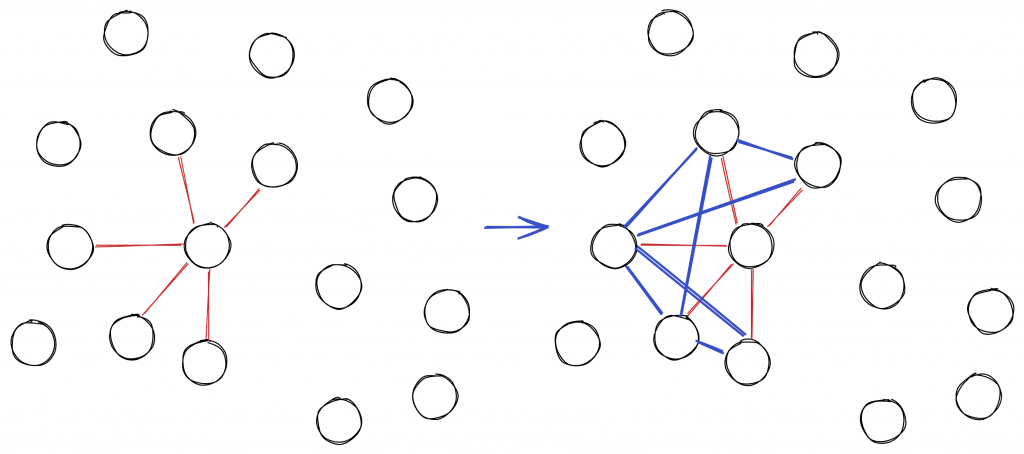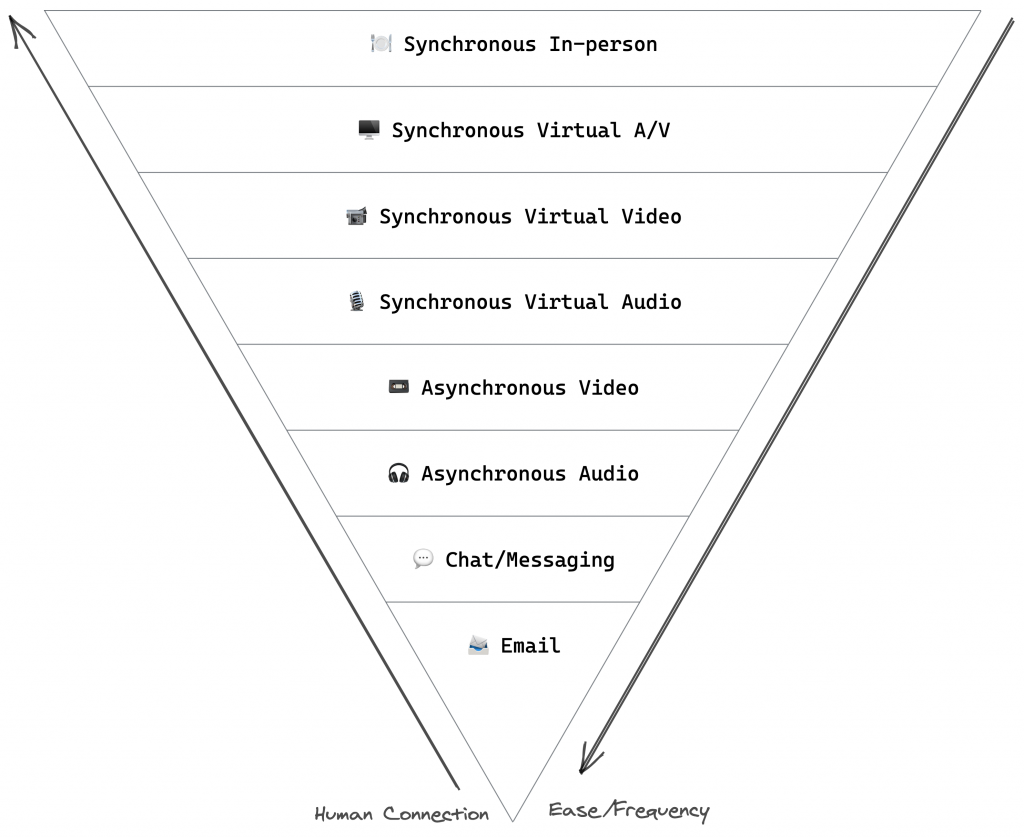What’s next for me
After moving on from the company I founded in 2011 and sold in 2019, I’ve been actively building a new venture that has been tumbling around in my head for years. I’ve spent the better part of the past two years especially navigating the concept idea maze, researching, and engaging in active discussion with others to “bring it down to earth.” As part of furthering that process, what follows is fleshing out the underlying thesis behind the concept we’re currently pursuing. My mission for my next chapter is to bring humanity back together again, and this manifestation best represents the direction I’m setting out in.
The best relationships – the ones that don’t just fulfill a short term need, but the deep, generative connections that lead to a life well lived – are created through trusted hosts bringing people together in intimate social experiences. That is a critical and missing piece of our increasingly digital-centric social lives. We aim to build that in my new venture (final name TBD).
It’s been an exciting evolution, and, after having experienced years of running a product post-product market fit, it’s been humbling to go back to the ground floor and have many unanswered questions. At some point I’ll publish more about the first pilot we ran, which evolved into what we’re building now.
We’ve lost the foundation that formed our social fabric
I documented much of my foundational thinking in The Age of Belonging and The Next Social Platform Won’t Be Individualistic, but to summarize my underlying points:
- The pendulum of society has the opportunity to swing back from the (oft-toxic hyper-)individualism we find ourselves in today towards one that champions community and belonging – and the signs are starting to emerge.
- The root problem around most social platforms is they are built around – and therefore enforce – individualistic needs, opening up the opportunity for new platforms to be formed around the shifting societal need for deep relationships. First we shape the tools, then the tools shape us.
If we were to build off those foundational insights, that raises the key question – what would this look like, how would it work? What is the platform that enables and accelerates the cultivation of a web of deep relationships?
When we look at how we as a society used to find our place in the world, it’s clear to see that we’ve “lost our tribe.” We are no longer living within a few hundred feet of our greater families and friends, instead, nuclear families are on solitary islands, and more people are living alone than ever before. Social institutions that used to create community – namely religious – are on the decline. The rise in remote work and increasing obsoleteness of lifetime employment is limiting our ability to find our community in our 9-5.
If that is not proof enough, it’s clear we just don’t trust institutions anymore.

What do we trust, however? People we know.
We trust people to bring us together
If you were to find in your inbox a message sent from a website you had visited previously, inviting you to an event, there’s a high likelihood you’d skip right over it. There’s no social contract there. We are flooded with them.
If you were to instead receive a personal invite from a long-time trusted associate inviting you to an event, there’s a high likelihood you would strongly consider it. That’s because there is a social contract – namely trust – between you two. As their reputation is at stake if you were to have a negative experience, you can put high trust that they are only inviting you because they believe it will be worth your time. This is no surprise, we are innately social creatures, reliant on our existing trust circle to identify who/what else we can trust. Through those trusted relationships and the experiences they generate, we interact, develop friendships, and deepen relationships. The outsized majority of romantic relationships still originate through mutual introductions.

So if the how we connect is through a trusted broker, then we can look at where/what/when we connect with others.
How do we build the best hosted experience?
There are a number of mediums through which social connection can happen, although it’s abundantly clear that the highest-bandwidth relationship building is done synchronously – allowing the immediate feedback loop of seeing peoples reactions and body language, the quick volleying of thought and emotion back and forth, and the ability to exit with some outcome achieved. At work, it’s meeting. Outside, it’s the dinners, the salons, the intimate gatherings, the coffee meetings. The bottom of the period, email, pales in comparison to the bandwidth of interaction and level of intimacy and belonging that can be created by a dinner with friends.
My previous company, Contactually, worked at the bottom of the period. We were a full-fledged CRM, with the primary output enabling professionals to maintain relationships by leveraging email and other asynchronous channels. That was sufficient enough for our customers job-to-be-done – maintain enough cadence with an existing relationship to increase the odds of new, repeat, or referral business. Recipients just had to remember they knew/trusted/liked you enough to respond when the time is right. Relatedly, one of the formative driving forces behind this new venture is the undertone of fervent Contactually users making an off-hand remark about Contactually making them feel “more human.” In a world where we are increasingly a mile-wide but only an inch deep with our relationships, anything that opened the door to repeat, and therefore potentially deeper, human connection evoked passion among our customers we didn’t expect to exist for a B2B SaaS product.

If a periodic email or text message alone can elicit those kinds of feelings, then it’s no surprise, as we all have experienced, the deep connections that can form around the dinner table. As we all know, meals, for years, have been the substrate upon which relationships are deepened, new connections are made, and generative opportunities are seeded. Not too far off are the salons and other intimate gatherings, bringing the right group of people, with weak or strong connections to each other, together in the right context to enable real connection.
Therein lies one of the other fundamental beliefs we hold. While we all cannot wait to meet in person, hug each other, and take advantage of the energy, body language, and other benefits of physical presence, we simultaneously owe it to ourselves to build the best virtual experiences possible. The genie is out of the bottle, and whether it’s due to our networks now being even further scattered around the globe, the elimination of commuting to and from a meeting, or the cost of a babysitter, interacting virtually will remain a critical part of our social health. For that reason, we have to explore what the “best virtual dinner” looks like. It would be a mistake to myopically think about all the aspects of in-person gatherings and think about how they translate online. Rather, we can take the essence of intimate group experiences (more in the future around our experiments and research around 1:1 vs groups), look at all the steps needed to achieve the best outcomes, and then identify the best digital experience. What can we do offline that we couldn’t do online? What does digital provide that is arduous or impossible in the real world? And how could we translate from online back to offline, and vice versa?
“Here’s the formula if you want to build a billion-dollar internet company. Take a human desire, preferably one that has been around for a really long time…Identify that desire and use modern technology to take out steps.”
Ev Williams
How can we make it easier to curate the right people and the right experience?
Bringing back our core mission, if intimate small group experiences are the solution to deep connection and our way out of this epidemic of loneliness, then we have to figure out how to exponentially increase the frequency and reach of great events, to every corner of the globe. And at the center of these intimate gatherings is a really great host. How do we help connectors host and facilitate more events? Relatedly, and this is a big bet we have, how can we reduce the level of effort and energy required to gather people, to lower the barrier to entry and bring more people into the arena, connecting their own families and friends and disparate communities?
We’ve had the opportunity to interview dozens of conveners, brokers, and expansionists, and pick apart their motivations and systems (as much as possible) to understand where we can reduce friction and increase impact. The picture continues to develop, but it has become all the more clear that a great gathering takes into consideration two things – the right people and the right experience.
Right People – Who should be here? Are these people who know each other already and seek to galvanize or deepen their connection? Are these second degree connections to each other, all with a first degree relationship with the host? Is there some generative or transactional value by this group knowing each other? Would they “vibe” with each other, or have some other common ground upon which to build a relationship? Some of the best hosts we know go as far as seating people side by side based on some hidden characteristic, unbeknownst to the attendees (What a strange coincidence that we grew up in the same neighborhood!). The more we explore this and look through the lists, spreadsheets, and databases that great connectors have concocted to facilitate matching, it becomes clear that there is an opportunity to aid the right connections through the right kind of tool.
Right Experience – There’s some kind of magic in the room that turns an obligatory “when is it socially acceptable to leave” event into “can this night never end?” Just having the right people around a table does not guarantee that anything will happen. With the state of social interactions, we often revert to the lowest common denominator of conversation. This is where great facilitation – by great conveners – kicks in. They don’t just let people figure it out themselves, rather, they take an intentional approach to create the right container for relationships to emerge. Priya Parker, in her seminal book The Art of Gathering, refers to this as “generous authority.”
I’m thankful enough to have the opportunity to sit at the table of many great hosts, who don’t just think about the right people, but everything about the experience to evoke real vulnerability, and through that, connections form. One such facilitator notes that if he doesn’t have multiple people cry during one of their scripted evenings, something has gone wrong. Another knows everyone’s dietary restrictions and preferences and handles all the ordering, so the conversation isn’t sidetracked by peering at menus. Research by Irrational Labs demonstrates that the more facilitated an interaction is – as simple as having instructions and questions on the table – can break through the tedious superficiality of a networking event enough to create real connections. How does that translate online? How can a host rely on the expertise of a facilitator, without the facilitator being in the room? Can we never do another “Zoom happy hour” again?
What is the (initially) digital evolution? We’ll show you in the coming weeks.
“I would do this instead of Netflix” – An early beta tester
One of our advisors, the author Charles Vogl, helped frame it best. We will never replicate the true magic, connection, and art of a hosted and facilitated in-person event. But for the world as it is today, it may not be a legendary H&H Bagel, but giving everyone a good freezer bagel is better than anything they normally have access to. We can take advantage of an entirely different medium, and do something that otherwise couldn’t exist for billions of people.
If you’re interested in joining one of our beta tests, reach out here. If you’re interested in getting involved with this early stage adventure, I’m always happy to talk. You can sign up for the beta at our current landing page, http://whatisrally.com/. We’re hiring for a few key roles, including UI design and engineering, so reach out if interested.
Thanks to friends Sara Stibitz, Deidre Woollard, Julie Weber, and Bryan Wish for their advance read/edits.
Totally intrigued and love to learn more
I’m all about connecting humans through play. Initially in person. Now with JAM virtual as well. Let me know how I can help
I’m very interested in being a beta tester! Anything I can do to support.
I support you and this mission. Big Love!
Sounds like a way of creating digital third spaces, love it!
3p3ndg
36qcr5